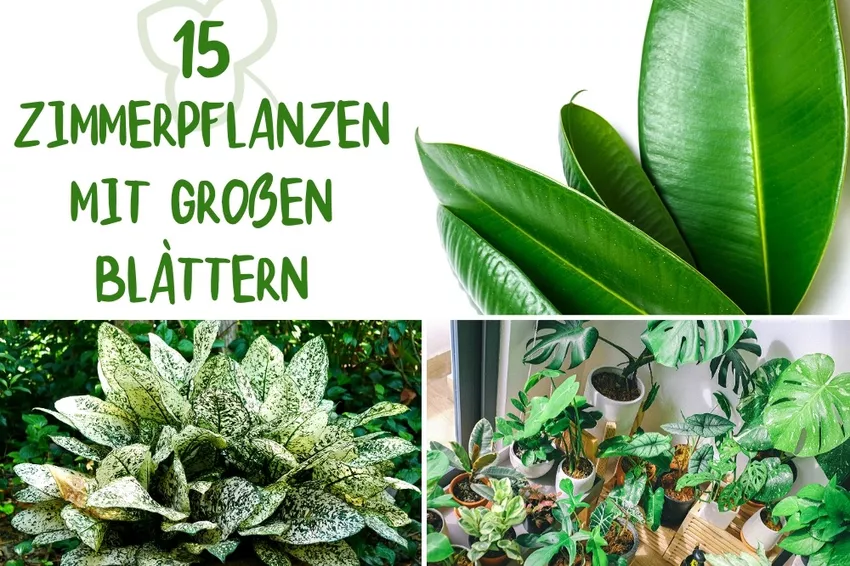
Most houseplants that develop showy leaves are from the aroid family. In addition to these tropical species, there are other plants with attractively large leaf areas.
Sun
Houseplants that develop noticeably large leaves even under sunny conditions must protect their leaf surfaces from sunburn and too much evaporation. They develop coarse foliage that is often leathery to the touch. The thick leaf tissue can store water better. In addition, dyes in the leaves ensure that the chlorophyll is not destroyed by too much sunlight. The indoor plants often have dark green or reddish foliage and are particularly attractive to look at. An optimal water supply is of great importance for the vitality of indoor plants.
Notice: Not many tropical plants with large leaves can tolerate direct sunlight. They thrive better in indirectly sunlit locations.
Tree Strelitzia
 Source: User:ShineB, Strelitzia nicolai, edited by Plantopedia, CC BY-SA 3.0
Source: User:ShineB, Strelitzia nicolai, edited by Plantopedia, CC BY-SA 3.0
- botanical: Strelitzia nicolai
- Leaves: up to three meters long and 50 centimeters wide, reminiscent of banana leaves
- Height: about 200 to 500 centimeters
- Substrate: loamy-sandy potting soil with good quality and high permeability
- Nutrients and water: water and fertilize regularly from April to October
- Location: prefers a warm place with light conditions
- Special feature: older specimens bloom in a similar way to bird-of-paradise flowers
dessert banana
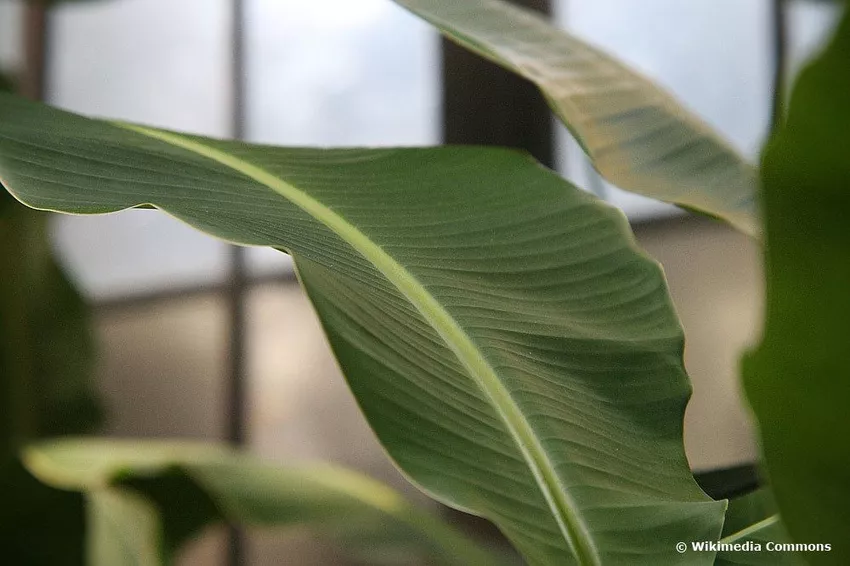 Source: Photo by David J. Stang, Musa x paradisiaca Rajapuri 1zz, Edited by Plantopedia, CC BY-SA 4.0
Source: Photo by David J. Stang, Musa x paradisiaca Rajapuri 1zz, Edited by Plantopedia, CC BY-SA 4.0
- botanically: Musa x paradisiaca
- leaves: leathery with dark spots
- Height: about 200 to 300 centimeters
- Substrate: high-quality potting soil with coarse parts such as sand, gravel or grit
- Nutrients and water: keep the substrate constantly moist and fertilize weekly between April and September
- Location: permanently warm and humid
- Special feature: flowers from the age of three years
- attractive varieties: 'Dwarf Cavendish'
elephant ear
- botanical: Alocasia polly
- Leaves: arrow-shaped to heart-shaped and more or less strongly wavy, up to a meter in diameter
- Height: about 180 to 200 centimeters
- Substrate: nutrient and humus-rich substrate with high permeability, slightly acidic
- Nutrients and water: keep the substrate moist all year round, fertilize weekly between March and September
- Location: likes bright light conditions, a bit darker and cooler in winter
- Special feature: rarely blooms with bulb-shaped flowers
fiddle fig
 Source: Mokkie, Fiddle leaf fig 5, edited by Plantopedia, CC BY-SA 3.0
Source: Mokkie, Fiddle leaf fig 5, edited by Plantopedia, CC BY-SA 3.0
- botanically: Ficus lyrata
- Leaves: leathery and wrinkled, up to 50 centimeters long and more than 20 centimeters wide
- Height: about 200 to 400 centimeters
- Substrate: humus-rich and well-drained soil
- Nutrients and Water: Keep moderately moist during the growing season and fertilize weekly
- Location: sunny place without direct draft
- Special feature: the reeds are reminiscent of a lyre
rubber tree

- botanically: Ficus elastica
- Leaves: coarse and glossy, up to 30 centimeters long
- Height: about 100 to 200 centimeters
- Substrate: sandy soil with a high proportion of coconut fibres
- Allow soil to dry on the surface before watering, fertilize indoor plants every two weeks from spring to summer
- Location: bright and warm with temperatures of at least 18 degrees
umbrella tree
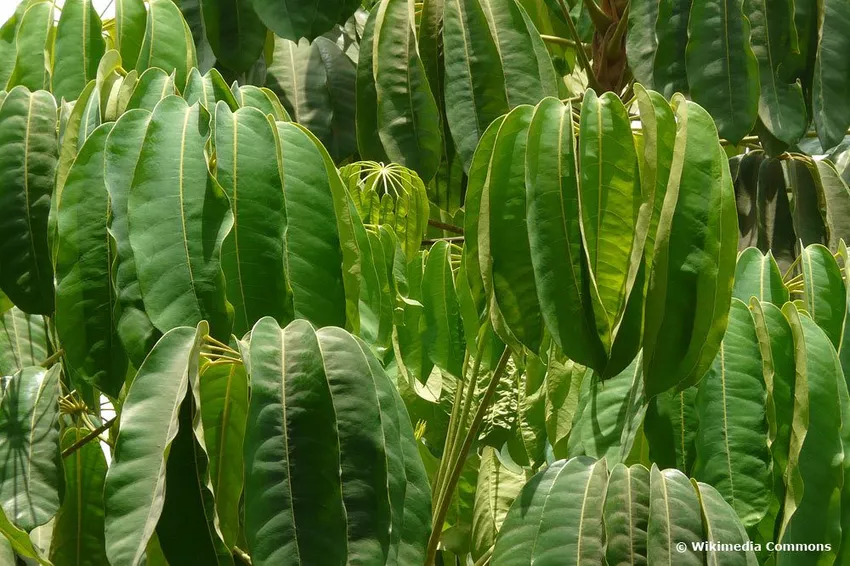 Source: Dinesh Valke from Thane, India, Octopus tree (3489086546), Edited by Plantopedia, CC BY-SA 2.0
Source: Dinesh Valke from Thane, India, Octopus tree (3489086546), Edited by Plantopedia, CC BY-SA 2.0
- botanical: Schefflera actinophylla
- Synonyms: Large-leaved Schefflera, Queensland's Ray's Aralia
- Leaves: finger-shaped divided, partial leaflets 10 to 40 centimeters long, petiole 15 to 50 centimeters
- Height: about 150 to 300 centimeters
- Substrate: high-quality, well-drained potting soil
- Nutrients and water: constantly moist soil without waterlogging, fertilize regularly from April to September
- Location: bright place with indirect sunlight
- attractive varieties: 'Amate'
Tiger Arrow Leaf
 Source: Photo by David J. Stang, Alocasia zebrina 4zz, Edited by Plantopedia, CC BY-SA 4.0
Source: Photo by David J. Stang, Alocasia zebrina 4zz, Edited by Plantopedia, CC BY-SA 4.0
- botanically: Alocasia zebrina
- Synonyms: alocasia, tropical root
- Leaves: Multicolored, heart-shaped to arrow-shaped, up to 35 centimeters in size
- Height: about 60 to 100 centimeters
- Substrate: permeable and nutrient-rich potting soil
- Nutrients and water: moderate to high water requirements, fertilize during the growth phase
- Location: bright location with temperatures between 22 and 25 degrees
- attractive varieties: 'Tiger'
penumbra
Locations exposed to morning or evening sun are well suited for most houseplants with large leaves. However, their tolerance range with regard to light usually extends over a wide scale. For you, this means that you can also cultivate many indoor plants from the lists for sunny and shady locations in partial shade.
Dieffenbachia
 Source: Photo by David J. Stang, Dieffenbachia maculata Rudolph Roehrs 2zz, Edited by Plantopedia, CC BY-SA 4.0
Source: Photo by David J. Stang, Dieffenbachia maculata Rudolph Roehrs 2zz, Edited by Plantopedia, CC BY-SA 4.0
- botanical: Dieffenbachia maculata
- Leaves: White or yellow-green patterned, pointed and up to 25 centimeters long
- Height: about 60 to 200 centimeters
- Substrate: Potting soil with a handful of charcoal chips or expanded clay
- Nutrients and water: keep moist year-round, fertilize every two weeks between spring and fall
- Location: warm place with temperatures between 21 and 30 degrees, high humidity
- Special feature: rarely planted flowers inhibit growth and should be removed shortly after flowering
- attractive varieties: 'Maroba', 'Reflector', 'Tropic Snow', 'Vesuvius'
homologue
 Source: Daderot, Homalomena rubescens - Shinjuku Gyo-en Greenhouse - Tokyo, Japan - DSC05856, Edited by Plantopedia, CC0 1.0
Source: Daderot, Homalomena rubescens - Shinjuku Gyo-en Greenhouse - Tokyo, Japan - DSC05856, Edited by Plantopedia, CC0 1.0
- botanically: Homalomena rubescens
- Leaves: heart-shaped and acuminate, parent species with green foliage, some varieties variegated
- Height: about 100 centimeters
- Substrate: high-quality, well-drained potting soil
- Nutrients and water: Avoid dry bulbs, fertilize monthly between April and September
- Location: ideally semi-shady, also thrives in brighter places
- attractive varieties: 'Maggie', 'Lime'
Climbing philodendron
 Source: Photo by David J. Stang, Philodendron hederaceum hederaceum 0zz, Edited by Plantopedia, CC BY-SA 4.0
Source: Photo by David J. Stang, Philodendron hederaceum hederaceum 0zz, Edited by Plantopedia, CC BY-SA 4.0
- botanically: Philodendron scandens
- Synonym: Climbing tree friend
- Leaves: firm and heart-shaped, up to 30 centimeters in size
- Height: about 300 to 500 centimeters
- Substrate: nutrient-rich and loose soil
- Nutrients and Water: Keep moderately moist from spring through fall and fertilize every two weeks
- Location: bright place with temperatures between 20 and 25 degrees
- attractive varieties: 'Green Wonder'
the shade
Houseplants for shady locations are particularly easy to care for, because there is little evaporation through the leaves and you don't have to water them too often. In order to promote good health, you should not put the plants in full shade, but rather cultivate them a little brighter. A change of location between summer and winter is also possible.
Tip: Many houseplants with large leaves turn out to be good air purifiers. In order for the plants to be able to fulfill their function, you should regularly remove dust from the leaves.
A leaf
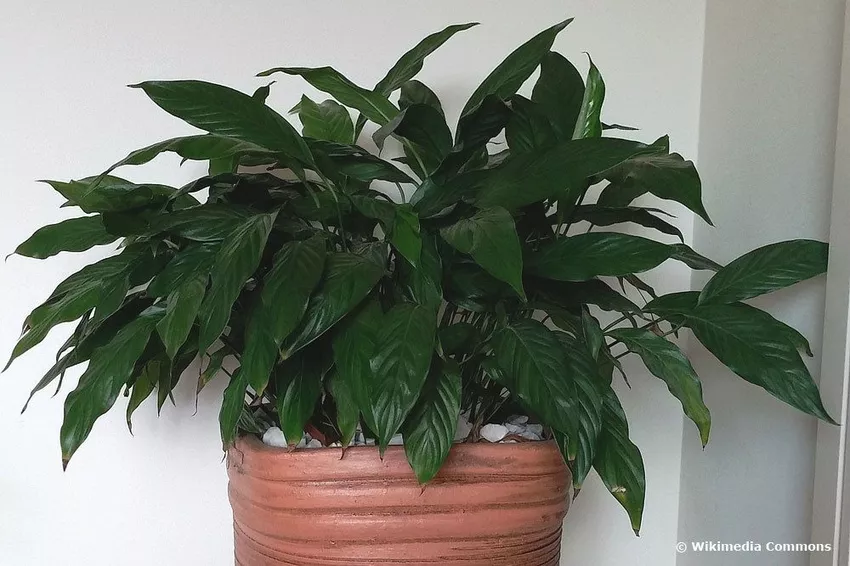 Source: DAR7, Spathiphyllum wallisii (2) 2015, Edited by Plantopedia, CC BY-SA 4.0
Source: DAR7, Spathiphyllum wallisii (2) 2015, Edited by Plantopedia, CC BY-SA 4.0
- botanically: Spathiphyllum wallisii
- Leaves: Glossy dark green and long-stalked, up to 25 centimeters
- Height: about 30 to 80 centimeters
- Substrate: conventional potting soil with a high proportion of humus
- Nutrients and water: keep the substrate constantly moist, fertilize weekly during the flowering period
- Location: preferably humid, avoid direct sunlight
- attractive varieties: 'Sweet Sebastiano', 'Sweet Lauretta'
Large-leaved radiant palm
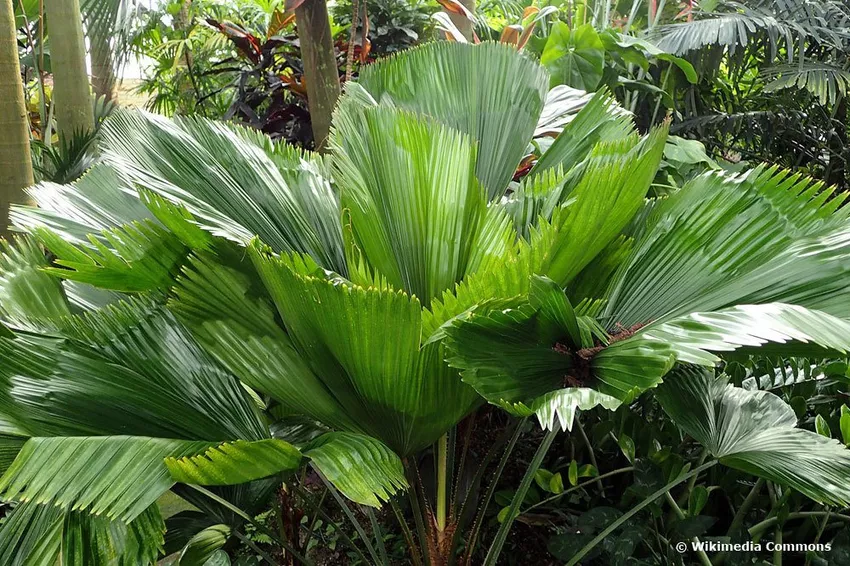 Source: Krzysztof Ziarnek, Kenraiz, Licuala grandis kz4, Edited by Plantopedia, CC BY-SA 4.0
Source: Krzysztof Ziarnek, Kenraiz, Licuala grandis kz4, Edited by Plantopedia, CC BY-SA 4.0
- botanical: Licuala grandis
- Synonym: Vanuatu radiant palm
- Leaves: rounded, up to 90 centimeters wide
- Height: up to three meters high, lower in indoor culture
- Substrate: Mixture of good quality potting soil and humus, mixed with perlite
- Nutrients and water: never let it dry out and fertilize weekly between spring and fall
- Location: thrives in light shade that is consistently warm and humid
- Special feature: forms only two to four leaves per year
cob thread
 Source: Forest & Kim Starr, Starr 070906-8788 Aglaonema commutatum, Edited from Plantopedia, CC BY 3.0
Source: Forest & Kim Starr, Starr 070906-8788 Aglaonema commutatum, Edited from Plantopedia, CC BY 3.0
- botanical: Aglaonema commutatum
- Leaves: Broadly lanceolate with silvery-white veins, up to 30 centimeters long
- Height: about 45 to 50 centimeters
- Substrate: high-quality potting soil with good structural stability
- Nutrients and Water: Keep soil evenly moist, fertilize weekly between spring and fall
- Location: warm place with temperatures between 20 and 25 degrees
- attractive varieties: 'Freedman', 'Cutlass', 'Stripes'
Delicious window leaf

- botanically: Monstera deliciosa
- leaves: shield-shaped, up to 50 centimeters long
- Height: about 50 to 300 centimeters
- Substrate: nutrient-rich and well-drained potting soil
- Nutrients and water: water regularly but sparingly, fertilize every two weeks between April and August
- Location: humid
- Special feature: slashed leaves occur in locations where the light comes from all sides
skeleton plant
 Source: Forest & Kim Starr, Starr-110209-0812-Alocasia x amazonica-leaves-Resort Management Group Nursery Kihei-Maui (24444063964), Edited by Plantopedia, CC BY 3.0 US
Source: Forest & Kim Starr, Starr-110209-0812-Alocasia x amazonica-leaves-Resort Management Group Nursery Kihei-Maui (24444063964), Edited by Plantopedia, CC BY 3.0 US
- botanical: Alocasia x amazonica
- Synonym: arrow leaf, elephant ear
- Leaves: Dark green with light and clearly protruding veins, purple-reddish underside
- Height: about 40 to 60 centimeters
- Substrate: well-drained and nutrient-rich soil
- Nutrients and water: must not dry out, fertilize moderately
- Location: also thrives in sunny and semi-shady places
- attractive varieties: 'Polly'